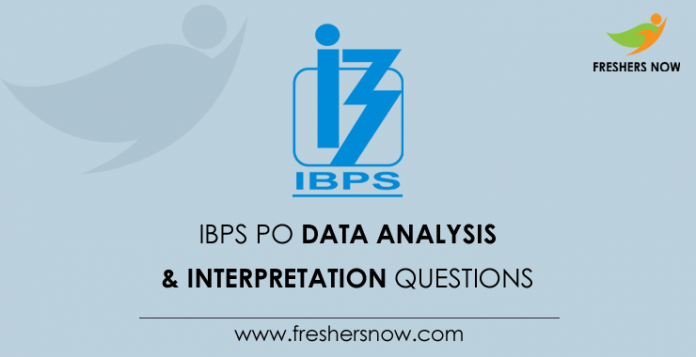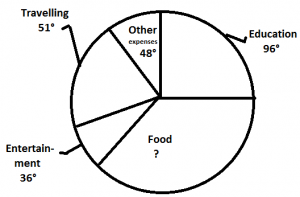
IBPS PO Data Analysis & Interpretation Questions and Answers PDF Download (Mains): Are you preparing for the IBPS PO written exam? If yes, then candidates need to check this entire page. We have provided IBPS PO Data Analysis & Interpretation Questions and Answers as well as IBPS PO Data Analysis & Interpretation Quiz on this page.
★★ IBPS PO Mains Free Mock Tests ★★
By practicing the IBPS Mains PO Data Analysis & Interpretation Questions/ Data Analysis and Interpretation Questions for IBPS PO, aspirants can easily qualify in the mains exam and proceed to the further selection process. To assist the aspirants, we have also provided an IBPS PO Data Analysis & Interpretation Mock Test. Check this entire page for more information regarding the IBPS PO Data Analysis & Interpretation Online Test.
IBPS PO Data Analysis & Interpretation Online Test | Mains Exam
Directions (1-6): Study the following line chart carefully and answer the questions given beside.
The following line graph gives information about the percentage increase in the turnover of four companies (Patanjali, Reliance, Airtel, and Accenture) during the year 2012 to 2017 with respect to the previous year.

1. If at the end of the year 2011, the turnover of Patanjali was 25% less than the turnover of Airtel then at the end of 2014, the turnover of Patanjali was how much percent less than the turnover of Airtel? (approximately)?
A. 40%
B. 60%
C. 51%
D. 81%
Answer – Option D
2. If at the end of 2015, the turnover of Patanjali was 75% of the turnover of Airtel, turnover of Airtel was 60% of the turnover of Accenture and the turnover of Accenture was 80% of the turnover of Reliance. If it is given that the turnover of Reliance at the end of 2015 was $ 1.75 billion. Then what was the sum of the total turnover of all the companies together at the end of 2017? (round off two decimal)?
A. $ 12.25 billion
B. $ 14.21 billion
C. $ 7.48 billion
D. $ 9.64 billion
Answer – Option A
3. If the total turnover of Patanjali at the end of 2012 was $ 1 billion then find the total turnover of Patanjali at the end of 2017? (round off two decimal)?
A. $ 6.21 billion
B. $ 7.21 billion
C. $ 4.58 billion
D. $ 9.64 billion
Answer – Option C
4. At the end of 2012, the respective ratio of the turnover of Patanjali, Reliance, Airtel, and Accenture was 2: 7: 4: 5 then what was the respective ratio of the turnover of all the companies at the end of 2011?
A. 40/21: 28/5: 7/2: 50/11
B. 40/21: 28/5: 5/2: 50/11
C. 40/21: 28/5: 7/2: 40/11
D. 20/21: 14/5: 5/4: 25/11
Answer – Option D
5. Which of the following shows the approximate percentage increase in the turnover of Accenture during the six years?
A. 450 %
B. 500 %
C. 600 %
D. 550 %
Answer – Option B
6. For which of the following company, the approximate percentage increase in the turnover during the six years was highest?
A. Airtel
B. Reliance
C. Accenture
D. Patanjali
Answer – Option A
Directions (7-11): Study the following the pie-chart and table carefully to answer the questions given below:
The following pie-chart shows the distribution of the monthly family budget of a person.

The following table shows the further distribution (in percent) of the above-mentioned items among the five family members i.e P (the person himself), W (his wife), Rahul (son), Rohit (son), and Preeti (his daughter). His monthly family budget is Rs. 1,20,000?

7. What is the average expenses of P?
A. Rs. 5620
B. Rs. 5640
C. Rs. 5460
D. Rs. 5480
Answer – Option C
8. What is the approximate percentage increase in the amount Which Rahul enjoys for entertainment as compared to Preeti for the same?
A. 33%
B. 31%
C. 371%
D. 35%
Answer – Option A
9. The average expenses of Rohit is approximately what percent of the average expenses of W (Wife)?
A. 76.4%
B. 81.5%
C. 79.5%
D. 83.5%
Answer – Option D
10. Find the difference (in the percentage of the budget) between the average expenses of Education and the average expenses on Entertainment of the couple?
A. 1.3%
B. 0.9%
C. 2%
D. 2.5%
Answer – Option A
11. The total amount spent by Rahul on Travelling and Food is approximately what percent of the total amount spent by Preeti on Education and Food?
A. 175%
B. 171%
C. 174%
D. 177%
Answer – Option B
Direction(12-16): Study the following table carefully and answer the question given below:
Classification of 100 students based on the marks obtained by them in Physics and Chemistry in an examination:

12. The number of students scoring less than 40% marks in aggregate is?
A. 13
B. 19
C. 20
D. 21
Answer – Option D
13. If at least 60% of marks in Physics are required for pursuing higher studies in physics, how many students will be eligible to pursue higher studies in Physics?
A. 27
B. 32
C. 34
D. 41
Answer – Option B
14. What is the difference between the number of students passed with 30 as cut-off marks in chemistry and those passed with 30 as cut-off marks in aggregate?
A. 3
B. 4
C. 5
D. 6
Answer – Option D
15. The percentage of the number of students getting at least 60% marks in Chemistry over those getting at least 40% marks in aggregate, is approximate?
A. 21%
B. 27%
C. 29%
D. 31%
Answer – Option C
16. If it is known that at least 23 students were eligible for a Symposium on Chemistry, the minimum qualifying marks in Chemistry for eligibility to Symposium would lie in the range?
A. 20-30
B. 40-50
C. Below 20
D. Cannot be determined
Answer – Option A
Direction (17-21): Study the following bar-graph and answer the question given below:
Production of Fertilizers by a company (in 10000 tonnes) over the Years.

17. In how many of the given years was the production of fertilizers more than the average production of the given years?
A. 1
B. 2
C. 3
D. 4
Answer – Option D
18. The average production of 1996 and 1997 was exactly equal to the average production of which of the following pairs of years?
A. 2000 and 2001
B. 1995 and 2001
C. 1998 and 2000
D. 1995 and 1999
Answer – Option B
19. What was the percentage decline in the production of fertilizers from 1997 to 1998?
A. 33%
B. 30%
C. 25%
D. 21%
Answer – Option C
20. In which years was the percentage increase in production as compared to the previous year the maximum?
A. 2001
B. 2002
C. 1999
D. 1996
Answer – Option D
21. What was the percentage increase in the production of fertilizers in 2002 compared to that in 1995?
A. 320 %
B. 220 %
C. 200 %
D. 150 %
Answer – Option C
Directions (22-26): The following pie-chart shows the percentage distribution of the expenditure incurred in publishing a book. Study the pie-chart and the answer the questions based on it.
Various Expenditures (in percentage) Incurred in Publishing a Book

22. If for a certain quantity of books, the publisher has to pay Rs. 30,600 as printing cost, then what will be the amount of royalty to be paid for these books?
A. Rs. 19,450
B. Rs. 21,200
C. Rs. 22,950
D. Rs. 26,150
Answer – Option C
23. What is the central angle of the sector corresponding to the expenditure incurred on Royalty?
A. 15°
B. 24°
C. 54°
D. 48°
Answer – Option C
24. The price of the book is marked 20% above the C.P. If the marked price of the book is Rs. 180, then what is the cost of the paper used in a single copy of the book?
A. Rs. 36
B. Rs. 37.50
C. Rs. 42
D. Rs. 44.25
Answer – Option B
25. If 5500 copies are published and the transportation cost on them amounts to Rs. 82500, then what should be the selling price of the book so that the publisher can earn a profit of 25%?
A. Rs. 187.50
B. Rs. 191.50
C. Rs. 175
D. Rs. 180
Answer – Option A
26. Royalty on the book is less than the printing cost by:
A.5%
B. 35%
C. 20%
D. 25%
Answer – Option D
Directions (27-31): The bar graph given below shows the sales of books (in thousand number) from six branches of a publishing company during two consecutive years 2000 and 2001?
Sales of Books (in thousand numbers) from Six Branches – B1, B2, B3, B4, B5 and B6 of a publishing Company in 2000 and 2001.

27. What is the ratio of the total sales of branch B2 for both years to the total sales of branch B4 for both years?
A. 2:3
B. 3:5
C. 4:5
D. 7:9
Answer – Option D
28. Total sales of branch B6 for both the years is what percent of the total sales of branches B3 for both the years?
A. 68.54%
B. 71.11%
C. 73.17%
D. 75.55%
Answer – Option C
29. What percent of the average sales of branches B1, B2 and B3 in 2001 is the average sales of branches B1, B3 and B6 in 2000?
A. 75%
B. 77.5%
C. 82.5%
D. 87.5%
Answer – Option D
30. What is the average sales of all the branches (in thousand numbers) for the year 2000?
A.73
B. 80
C. 83
D. 88
Answer – Option B
You Can Also Check: ★ IBPS PO Salary ★
31. Total sales of branches B1, B3 and B5 together for both the years (in thousand numbers) is?
A. 250
B. 310
C. 435
D. 560
Answer – Option D
Directions (32-35): Six friends are sitting in a circle and are facing the center of the circle. Deepa is between Prakash and Pankaj. Priti is between Mukesh and Lalit. Prakash and Mukesh are opposite to each other.
32. Who is sitting right to Prakash?
A. Mukesh
B. Deepa
C. Pankaj
D. Lalit
Answer – Option D
Explanation:

Hence, Lalit is sitting right to Prakash.
33. Who is just right to Pankaj?
A. Deepa
B. Lalit
C. Prakash
D. Priti
Answer – Option A
34. Who are the neighbors of Mukesh?
A. Prakash and Deepa
B. Deepa and Priti
C. Priti and Pankaj
D. Lalit and Priti
Answer – Option C
35. Who is sitting opposite to Priti?
A. Prakash
B. Deepa
C. Pankaj
D. Lalit
Answer – Option B
IBPS PO Data Analysis & Interpretation Questions and Answers PDF Download Link
| Important Links | |
| To Download IBPS PO Data Analysis & Interpretation Questions and Answers PDF | Download Questions & Answers |
Dear users, keep practicing more and more model papers to crack the IBPS PO exam. We are here to help you by providing various materials for your learning. Candidates are advised to bookmark our FreshersNow page for the latest updates. Thank You.
IBPS PO Data Analysis & Interpretation Q&A – FAQs
How to download IBPS PO Data Analysis & Interpretation Questions & Answers PDF?
Cadidates can download the IBPS PO Data Analysis & Interpretation Questions and Answers PDF through the direct link attached to our freshersnow.com portal.
How many questions will be asked in the IBPS PO Data Analysis & Interpretation Section?
35 Questions will be asked in the IBPS PO Data Analysis & Interpretation section.
Is there any sectional time limit for the IBPS PO Data Analysis & Interpretation section?
Yes, there is 45 mins sectional time limit for the IBPS PO Data Analysis & Interpretation section.
For how many marks, the Data Analysis & Interpretation Section in the IBPS PO Exam will be conducted?
The IBPS PO Data Analysis & Interpretation section will be conducted for 60 Marks.



